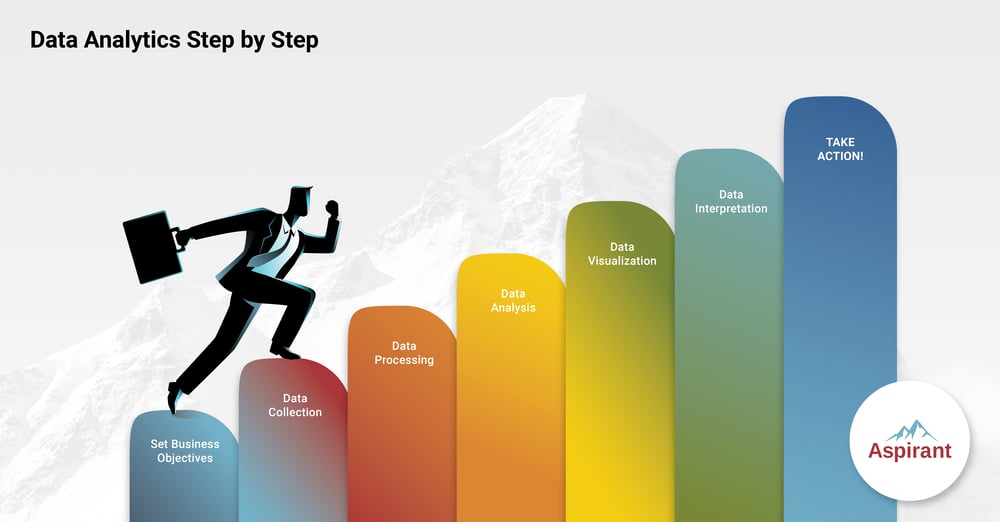by Aspirant Team
May 1, 2023
Data analytics is an ever-evolving component of business analytics that helps businesses make better decisions and drive productivity. Regardless of a company's size or industry, the ability to translate raw data into actionable insights is critical to sustainable success.
Skilled analysts can uncover trends from customer interactions, supply chain metrics, financial data, or any other business information that might otherwise go unnoticed. This can reveal opportunities for growth, cost savings, and improved processes across every aspect of the organization. With the right tools and expertise, the right data analytics strategy can help businesses stay ahead of the curve in an ever-evolving marketplace.
Depending on their size, industry, and key objectives, companies use a variety of data sources for analysis.
By applying natural language processing tools, a skilled data analyst is able to perform data analytics on qualitative data as well as quantitative data. Extracting the nuance from textual data from surveys, articles, or social media posts often generates the most valuable insights.
Organizations need to align on what they intend to accomplish through data analysis. A specific, methodical approach can then be tailored accordingly.
In this step, all available data is extracted, validated, and aggregated. Establishing direct integrations between databases and internal systems such as enterprise resource planning (ERP) and customer relationship management (CRM) platforms eliminates the hassle and risk of collecting data manually.
Jumping right into analyzing raw data is inefficient and ineffective. Data sets must be cleansed and transformed to address any inconsistent consistent formatting and organization. Effort to process data includes removing duplicates, handling missing values, and encoding categorical variables.
Data processing also involves normalization and scaling, which helps standardize data for comparison and analysis purposes. This essential step ensures that data is complete, reliable, and unbiased.
The data analysis process, including data mining, is where data is transformed into meaningful insights. A variety of data analytics tools are employed to identify trends, patterns, and relationships within large datasets. Advanced analytics algorithms and machine learning are being rapidly adopted for their ability to accelerate and improve statistical analysis.
The key is to ask the right questions and use the appropriate analysis to answer them. Data analysis must be thorough and maintain the integrity of large datasets.
The breadth and depth of the data being analyzed heavily determines its potential. The complex relationships between data points can be difficult to explain in terms of numbers in a spreadsheet. Specialized data visualization software helps create interactive charts, graphs, and other visual elements that are accessible and easy to understand - even for stakeholders who are not savvy with analytic data.
Interpretation is where business leaders draw conclusions from the data presented to them. Data modeling such as diagnostic analytics (diagnose why something happened), predictive analytics (predict future trends or events), and prescriptive analytics (recommend the optimal course of action) can lend some data-driven context.
All preceding data management and visualization must be executed properly in order for the analysis to be correctly interpreted. Miscues along the way could cause decision makers to form a skewed understanding of reality.
Despite all the work invested into the data analytics process and the sophistication of the analytical tools available to them, leaders still need to call on their intuition in making strategic decisions for their organizations. All data analytics techniques have bias and limitations that must be considered when it is time to take action.

Big data analytics seems poised to become tables stakes in the business world. The larger and more varied a data set is, the more accurate and useful predictive analytics becomes. The added horsepower of artificial intelligence (AI) and machine learning will enable organizations to leverage increasingly sophisticated models that will make decision-making nearly automatic. Businesses operating at the speed of information.
This may sound a bit pie-in-the-sky, but the adoption of these tools is already well underway. Leaders who embrace big data and prioritize the installation of business intelligence tools stand to create a sustainable advantage for their organizations.
Conversely, companies that put off the initiation of a business analytics program run a serious risk of being left in the dust.
Committing to data driven decision making is the first step for business leaders looking to data analytics to drive business performance. However, a variety of dynamics make this progression even more challenging than it seems, including:
Companies could try to build out these capabilities on their own by hiring for, or internally cultivating, the data analytics skills to collect, process, and analyze data. However, that approach requires more patience and risk tolerance than most leaders can spare. We can help.
Aspirant's team of data analysts and data science experts can flatten that learning curve. They design custom solutions that utilize all available data and generate the insight needed to make nimble strategic decisions. From supporting data mining to applying the latest data science methodologies to developing real-time dashboards to enabling business process automation (BPA), Aspirant is capable of implementing even the most ambitious analytics program.
We can also develop custom applications and integrations to create a comprehensive data collection infrastructure.
The people and processes are just as important as the technology when standing up an analytics program. Aspirant's Integrated Expertise provides direct access to all the cross-functional support companies need to being leveraging data as means for strengthening their strategic agility.